
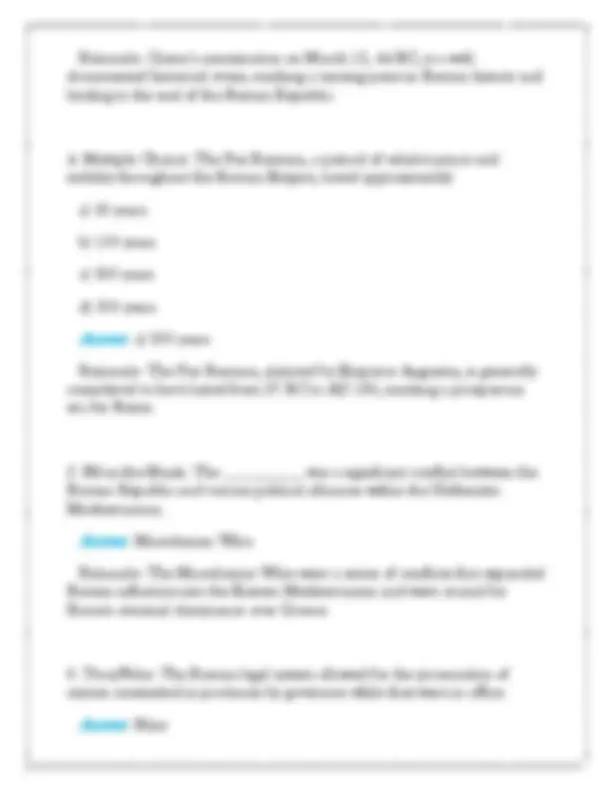
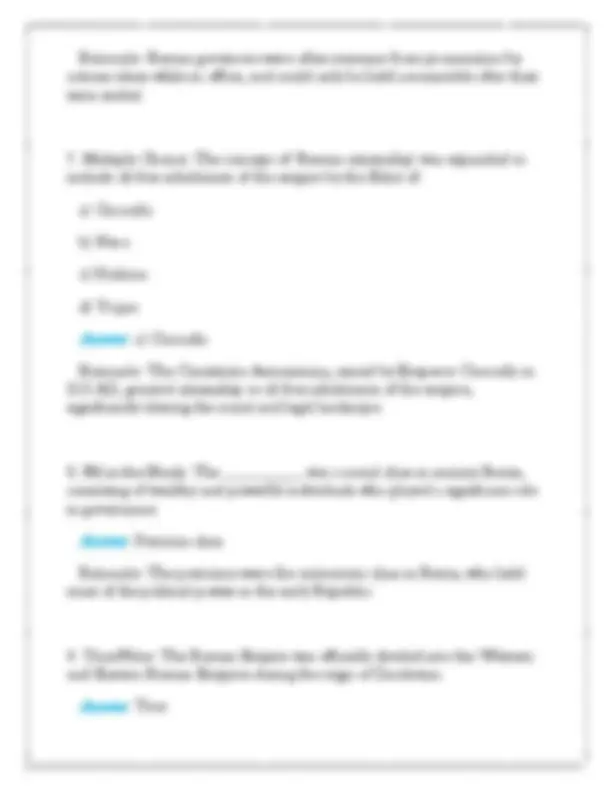
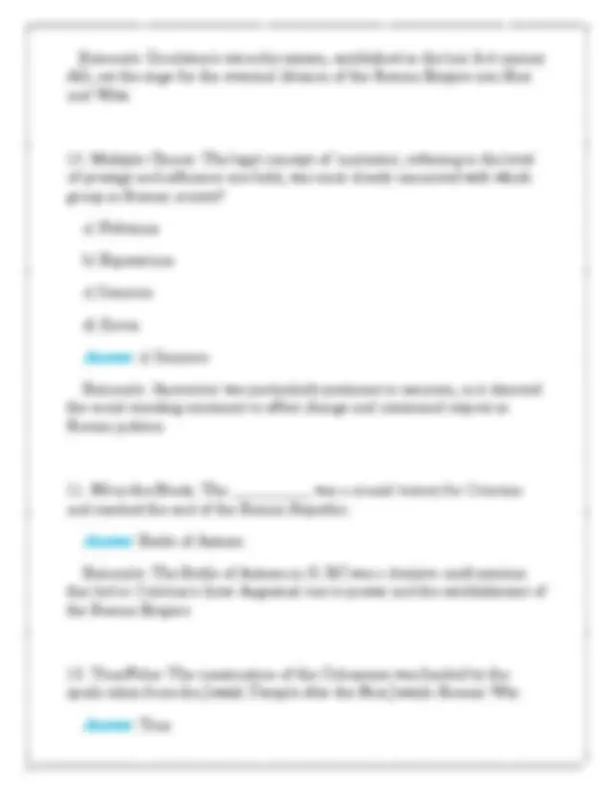

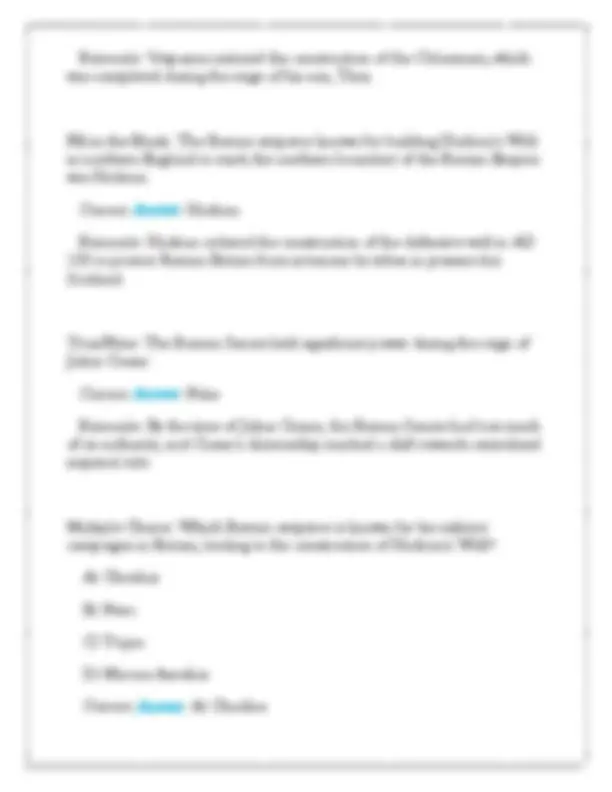

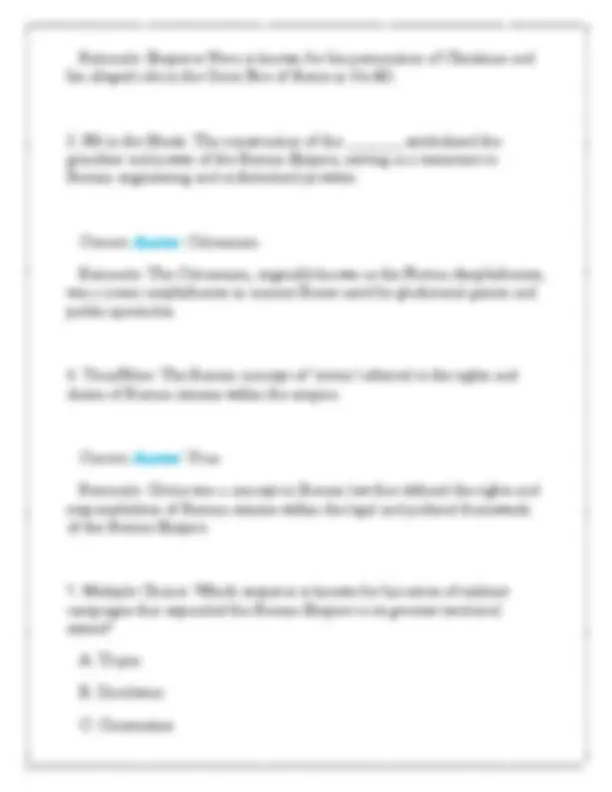

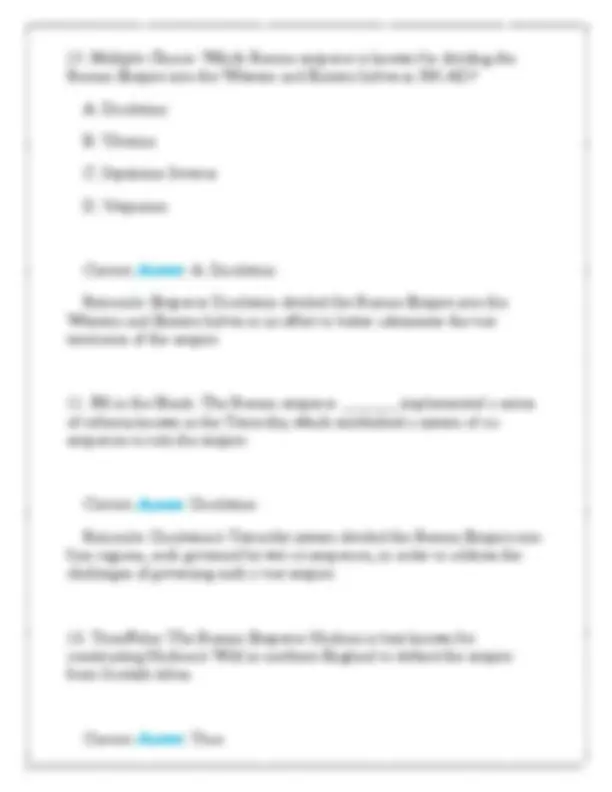
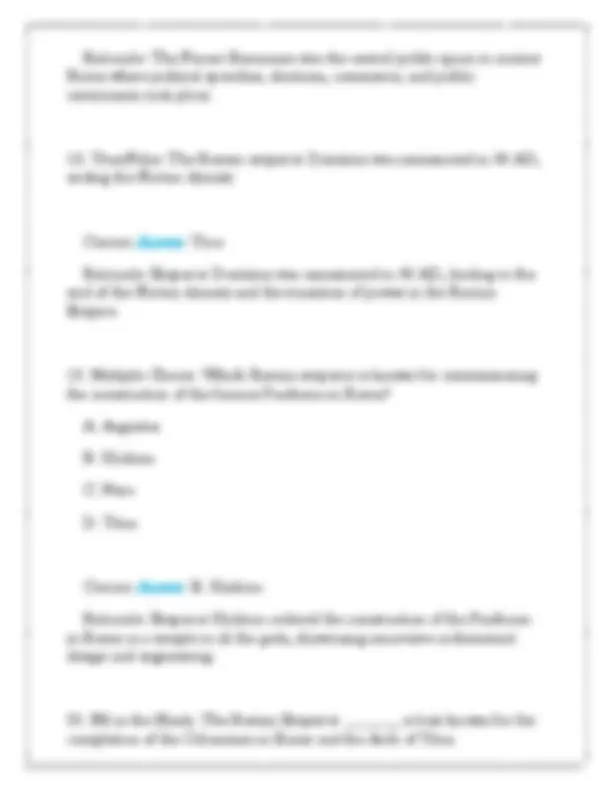



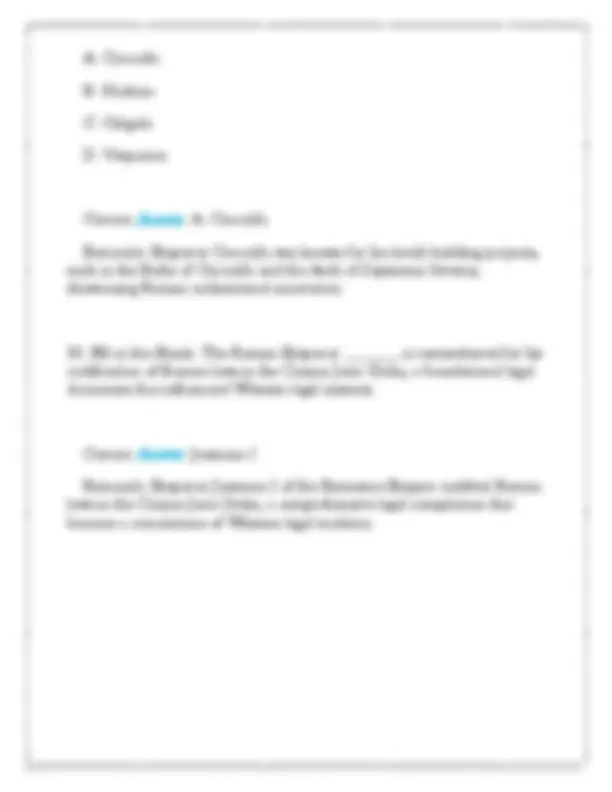


Study with the several resources on Docsity

Earn points by helping other students or get them with a premium plan


Prepare for your exams
Study with the several resources on Docsity

Earn points to download
Earn points by helping other students or get them with a premium plan
Community
Ask the community for help and clear up your study doubts
Discover the best universities in your country according to Docsity users
Free resources
Download our free guides on studying techniques, anxiety management strategies, and thesis advice from Docsity tutors
(UNE) ANCH312 Rome of the Caesars Midterm Exam Guide Q & S 2024(UNE) ANCH312 Rome of the Caesars Midterm Exam Guide Q & S 2024(UNE) ANCH312 Rome of the Caesars Midterm Exam Guide Q & S 2024(UNE) ANCH312 Rome of the Caesars Midterm Exam Guide Q & S 2024
Typology: Exams
1 / 22

This page cannot be seen from the preview
Don't miss anything!















Rationale: The Twelve Tables laid the foundation for Roman law, which included the presumption of innocence, a concept that has been carried into modern legal systems.
Rationale: The Plebeian Council was the legislative assembly of the plebeians, and played a key role in the checks and balances of Roman governance.
Rationale: Roman governors were often immune from prosecution for actions taken while in office, and could only be held accountable after their term ended.
Rationale: The Constitutio Antoniniana, issued by Emperor Caracalla in 212 AD, granted citizenship to all free inhabitants of the empire, significantly altering the social and legal landscape.
Rationale: The patricians were the aristocratic class in Rome, who held most of the political power in the early Republic.
Rationale: Diocletian's tetrarchy system, established in the late 3rd century AD, set the stage for the eventual division of the Roman Empire into East and West.
Rationale: 'Auctoritas' was particularly pertinent to senators, as it denoted the social standing necessary to effect change and command respect in Roman politics.
Rationale: The Battle of Actium in 31 BC was a decisive confrontation that led to Octavian's (later Augustus) rise to power and the establishment of the Roman Empire.
C) 1st century AD D) 3rd century BC
Rationale: Julius Caesar's rise to power occurred during the 1st century BC, specifically in the mid-1st century BC. Fill-in-the-Blank: The assassination of Julius Caesar took place on the Ides of March in the year 44 BC.
Rationale: The assassination of Julius Caesar by a group of Roman senators led by Brutus and Cassius occurred on March 15, 44 BC. True/False: Augustus was the first Emperor of Rome.
Rationale: Augustus, originally known as Octavian, was the first Emperor of Rome, establishing the Roman Empire after the death of Julius Caesar. Multiple Choice: Which Roman emperor famously declared himself a god during his reign? A) Augustus B) Caligula C) Nero D) Trajan
Rationale: Caligula was known for his megalomaniac tendencies, including declaring himself a god and demanding divine worship. Fill-in-the-Blank: The Pax Romana, a period of relative peace and stability in the Roman Empire, began during the reign of Emperor Augustus and lasted for approximately 200 years.
Rationale: The Pax Romana started with Augustus' rule and continued for around two centuries, characterized by minimal military conflicts within the empire. True/False: Nero is infamous for his persecution of Christians in ancient Rome.
Rationale: Nero's reign was marked by the persecution of Christians, particularly after the Great Fire of Rome in 64 AD, which some historians believe he may have instigated. Multiple Choice: Which Roman emperor commissioned the construction of the famous Colosseum in Rome? A) Trajan B) Nero C) Vespasian D) Hadrian
Rationale: Emperor Claudius launched successful military campaigns in Britain, leading to the Roman conquest of the island. Fill-in-the-Blank: The Roman Colosseum could hold approximately 50, spectators and was used for various forms of entertainment, including gladiatorial combats and public spectacles.
Rationale: The Colosseum was a massive amphitheater where Romans gathered to watch events like gladiator fights, animal hunts, and executions. True/False: Trajan was the first Roman emperor born outside of Italy.
Rationale: Trajan, who ruled from AD 98 to 117, was born in the Roman province of Hispania (modern-day Spain), making him the first non-Italian Emperor. Multiple Choice: Which Roman emperor famously persecuted Christians and blamed them for the Great Fire of Rome in 64 AD? A) Caligula B) Nero C) Domitian D) Tiberius
Rationale: Nero scapegoated the Christians for the fire that ravaged Rome and subjected them to brutal persecution.
Fill-in-the-Blank: The Roman poet Virgil is best known for his epic poem "The Aeneid," which tells the legendary story of Aeneas, a Trojan hero.
Rationale: Virgil's masterpiece, "The Aeneid," is a foundational work of Roman literature, recounting Aeneas's journey and the founding of Rome. True/False: The reign of Augustus marked the end of the Roman Republic and the beginning of the Roman Empire.
Rationale: Augustus' rise to power and establishment of the principate effectively ended the Roman Republic and ushered in the era of the Roman Empire.
Rationale: Augustus, also known as Octavian, is renowned for his administrative and political reforms that led to the Pax Romana and the consolidation of power in the Roman Empire.
Rationale: Emperor Nero is known for his persecution of Christians and his alleged role in the Great Fire of Rome in 64 AD.
Rationale: The Colosseum, originally known as the Flavian Amphitheater, was a iconic amphitheater in ancient Rome used for gladiatorial games and public spectacles.
Rationale: Civitas was a concept in Roman law that defined the rights and responsibilities of Roman citizens within the legal and political framework of the Roman Empire.
D. Titus
Rationale: Emperor Trajan is renowned for his military conquests that expanded the Roman Empire to its greatest territorial extent, including the annexation of Dacia.
Rationale: The Baths of Caracalla were one of the largest and most extravagant public bath complexes in ancient Rome, showcasing the opulence and engineering prowess of the Roman Empire.
Rationale: The Edict of Milan, signed by Constantine and Co-emperor Licinius, legalized Christianity and granted religious freedom to all religions in the Roman Empire, ending the persecution of Christians.
Rationale: Emperor Hadrian ordered the construction of Hadrian's Wall across northern England to protect Roman Britain from invasions by tribes from present-day Scotland.
Rationale: Emperor Marcus Aurelius is renowned for his "Meditations," a collection of his philosophical thoughts and reflections on Stoicism.
Rationale: Emperor Vespasian was hailed as "Pater Patriae" by the Roman Senate for his role in stabilizing the Roman Empire during the tumultuous Year of the Four Emperors.
Rationale: The paterfamilias was the male head of the Roman household who had extensive legal authority over his family, including the power to decide matters of life and death.
Rationale: Emperor Constantine became the first Roman emperor to convert to Christianity and issued the Edict of Milan, legalizing and favoring the Christian religion.
Rationale: Emperor Titus oversaw the completion of the Colosseum and the construction of the Arch of Titus, commemorating his victories in Judea.
Rationale: Ius civile encompassed the civil laws that applied specifically to Roman citizens, distinguishing them from other legal categories in Roman law.
Rationale: Emperor Trajan conducted successful military campaigns against the Parthian Empire and was commemorated with the construction of Trajan's Column in Rome.
Rationale: The Roman Civil Wars were a period of intense conflict and political turmoil that led to the fall of the Roman Republic and the establishment of the Roman Empire.
Rationale: Emperor Commodus, infamous for his erratic behavior and involvement in gladiatorial contests, was assassinated in 192 AD, marking the end of the Antonine dynasty.